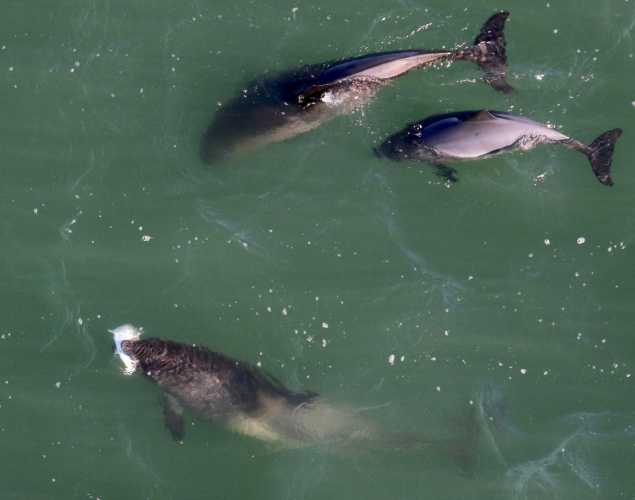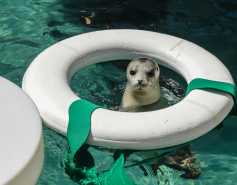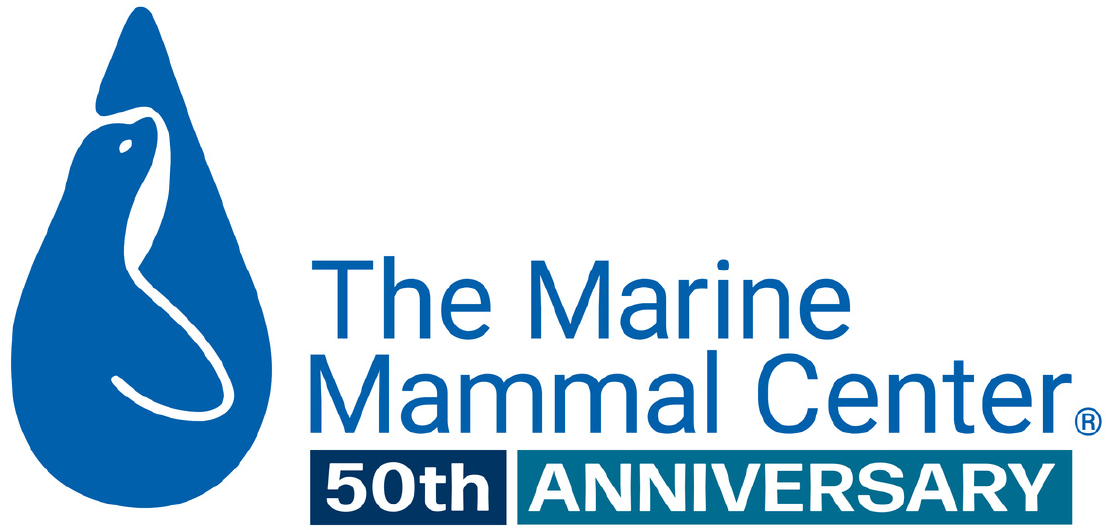
Prey-Related Suffocation in Harbor Porpoises
- Behavior
- Foraging
Abstract
Harbor porpoise (Phocoena phocoena) diets are predominantly comprised of small fish species (<30 cm) and squid. However, predation on larger species (up to 63 cm) occurs, raising the question of increased risk of asphyxiation associated with this behavior. Literature was reviewed and stranding data from 1983 to 2020 from the U.S. West Coast (including California, Oregon and Washington) were searched for cases of prey-related asphyxiation of harbor porpoises and analyzed in relation to age, sex, reproductive status and prey species. Twenty-nine cases were documented. Twenty-seven cases involved large prey; non-native American shad caused the asphyxiation in 87% of the cases where the prey species was identified. The majority (92%) of harbor porpoises were females, and at least 83.3% were pregnant or recently post-partum. Reproductively active females may be more likely to attempt potentially risky behavior in order to compensate for their increased energetic needs. Increasing numbers of non-native American shad may pose a unique danger in this region for harbor porpoises not adapted to deal with the challenges of that prey. This may be a cause for concern, as there is likely an interaction between location, age and reproductive status on the diet composition and foraging strategies of harbor porpoises.
Elliser, C.R., Calambokidis, J., D’Alessandro, D.N., Duffield, D.A., Huggins, J.L., Rice, J., Szczepaniak, I. and Webber, M., 2020, September. Prey-Related Asphyxiation in Harbor Porpoises (Phocoena phocoena) along the US West Coast: Importance of American Shad (Alosa sapidissima) on Adult Female Harbor Porpoise Mortality. In Oceans (Vol. 1, No. 3, pp. 94-113). Multidisciplinary Digital Publishing Institute.
Related Publications
{"image":"\/Animals\/Patients\/Harbor seals\/hs-by-bill-hunnewell-c-the-marine-mammal-center.jpg","alt":"harbor seal in a life preserver enrichment item","title":"Enrichment as a Tool for Rehabilitating Harbor Seals","link_url":"https:\/\/www.marinemammalcenter.org\/publications\/enrichment-as-a-tool-for-rehabilitating-harbor-seals","label":"Research Paper"}

{"image":"\/Animals\/Wild\/Humpback whale\/cropped-images\/humpback-whale-breach-golden-gate-by-pilar-rodriguez-c-the-marine-mammal-center-noaa-permit-26532-647-0-1710-1336-1702426697.jpg","alt":"humpback whale breaches with Golden Gate Bridge in the background","title":"New Urban Habitat for Endangered Humpback Whales: San Francisco Bay","link_url":"https:\/\/www.marinemammalcenter.org\/publications\/new-urban-habitat-for-endangered-humpback-whales-san-francisco-bay","label":"Research Paper"}

{"image":"\/Animals\/Wild\/Gray whale\/cropped-images\/gray-whale-baleen-shutterstock-526-1-3317-2591-1604510915.jpg","alt":"gray whale with mouth open above water","title":"Fish Feeding and Rapid Foraging Behavior Switching by Gray Whales (Eschrichtius robustus) in California","link_url":"https:\/\/www.marinemammalcenter.org\/publications\/fish-feeding-and-rapid-foraging-behavior-switching-by-gray-whales-eschrichtius-robustus-in-california","label":"Research Paper"}

Fish Feeding and Rapid Foraging Behavior Switching by Gray Whales (Eschrichtius robustus) in California
Read More{"image":"\/Animals\/Wild\/Other species\/cropped-images\/bearded-seal-shutterstock-622-6-4852-3789-1717182444.jpg","alt":"bearded seal on ice","title":"Comparative Muscle Physiology of Ringed, Bearded, and Spotted Seals from the Bering and Chukchi Seas","link_url":"https:\/\/www.marinemammalcenter.org\/publications\/comparative-muscle-physiology-of-ringed-bearded-and-spotted-seals-from-the-bering-and-chukchi-seas","label":"Research Paper"}

Comparative Muscle Physiology of Ringed, Bearded, and Spotted Seals from the Bering and Chukchi Seas
Read MoreRecent News
{"image":"\/Animals\/Patients\/Hawaiian monk seals\/2025\/cropped-images\/d-ru28release-exam-at-ke-kai-ola111025photo-by-giancarlo-rulli-c-the-marine-mammal-center-noaa-permit-24359-0-0-1270-992-1764620886.jpg","alt":"","title":"Bird Flu Vaccine Trial Offers Hope for Protecting Hawaiian Monk Seals","link_url":"https:\/\/www.marinemammalcenter.org\/news\/bird-flu-vaccine-trial-may-offer-hope-for-protecting-hawaiian-monk-seals","label":"News Update","date":"2025-12-01 08:13:00"}

Bird Flu Vaccine Trial Offers Hope for Protecting Hawaiian Monk Seals
December 1, 2025
Read More{"image":"\/Animals\/Patients\/Hawaiian monk seals\/2021\/hms-pp08-by-sheila-latta-c-the-marine-mammal-center-noaa-permit-18786.jpg","alt":"Hawaiian monk seal","title":"The New York Times: Inside the Bird-Flu Vaccine Trial for Monk Seals","link_url":"https:\/\/www.marinemammalcenter.org\/news\/the-new-york-times-inside-the-bird-flu-vaccine-trial-for-monk-seals","label":"In the News","date":"2025-12-01 01:00:00"}

The New York Times: Inside the Bird-Flu Vaccine Trial for Monk Seals
December 1, 2025
Read More{"image":"\/Animals\/Wild\/Sea otter\/so-wild-morro-bayphoto-c-brian-simuro-20.jpeg","alt":"Sea otter and pup","title":"Watch a Sea Otter Pup Reunite With Its Mother","link_url":"https:\/\/www.marinemammalcenter.org\/news\/watch-sea-otter-pup-reunite-with-its-mother","label":"News Update","date":"2025-11-14 10:35:41"}

{"image":"\/Animals\/Wild\/Sea otter\/sea-otter-photo-c-brian-simuro.jpeg","alt":"Sea otter","title":"AP News: Baby sea otter is reunited with mother in central California after dramatic rescue","link_url":"https:\/\/www.marinemammalcenter.org\/news\/ap-news-baby-sea-otter-is-reunited-with-mother-in-central-california-after-dramatic-rescue","label":"In the News","date":"2025-11-14 09:46:34"}

AP News: Baby sea otter is reunited with mother in central California after dramatic rescue
November 14, 2025
Read More
